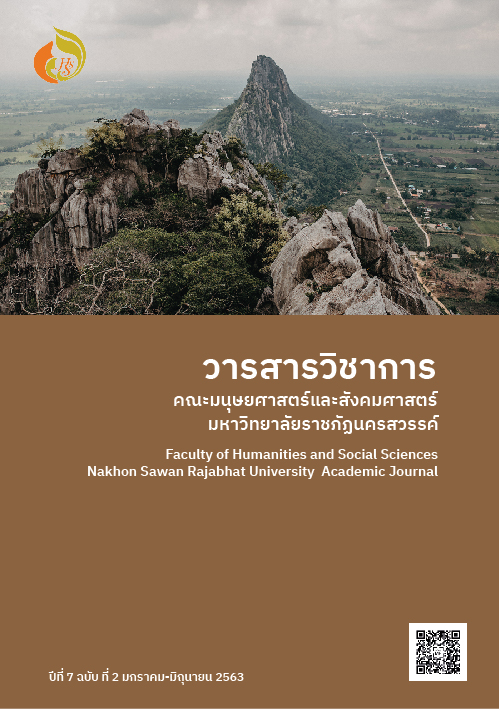Ranat Thum’s practicing process according to the style of Khru Uthai Kaewla-iad
Main Article Content
Abstract
This article aims to study Ranat Thum’s practicing process according to the style of Khru Uthai Kaewla-iad, the 2009 national artist in performing art Thai music, to create a concrete model of Ranat Thum’s practice for beginners. The author has collected the information from researches, textbooks, related papers, and the interview of Khru Uthai Kaewla-iad.
The study has found that the Ranat Thum’s practice in the style of Khru Uthai Kaewla-aid composes of the “good hands’’ and the “good head’’, the appropriated qualifications which Ranat Thum learners should possess. These qualifications are on the grounds of the Ranat Thum’s basic practicing process. The “good hands” is a result from knowing how to control the sticks and practice playing to achieve a good quality and a beauty of sounds, the skill of using the hands’ movement, as well as the practice of variating Ranat Thum tunes into various idiomatic melodies. This latter skill is considered as a significant knack representing the learner’s intelligence and wisdom. The method of Khru Uthai’s melody variation practice is that the learner must “learn” and “expand” from the teacher, collecting the knowledge within himself. After that, the learner will variate the melodies, from 10 melodies to 20 melodies, by dividing them in half before blending them together, resulting in a new idiomatic melody. Besides, the harmony between the conformity of the idiomatic melody and the pattern of using the hands’ movement should also be considered.
Article Details
References
กรมศิลปากร. (2545). คำบรรยายวิชาดุริยางคศาสตร์ไทย. กรุงเทพฯ: โรงพิมพ์ชวนพิมพ์.
เจตนา นาควัชระ. (2558). ผู้นำระนาดทุ้ม: บทสนทนากับ ศ. ดร.เจตนา นาควัชระ ว่าด้วยภาวะการนำ. นครปฐม: มหาวิทยาลัยมหิดล ศูนย์จิตตปัญญาศึกษา.
ดุษฎี มีป้อม. (2544). การศึกษาลักษณะทางเดี่ยวระนาดทุ้มเพลงพญาโศก ของครูพุ่ม บาปุยะวาทย์. (วิทยานิพนธ์มหาบัณฑิต). นครปฐม: มหาวิทยาลัยมหิดล.
ถาวร ศรีผ่อง. (2552). วิธีการจับไม้ระนาดเอก ใน สูจิบัตรงานประกวดดนตรีไทยแห่งชาติครั้งที่ 3 ชิงถ้วยรางวัลพระราชทาน สมเด็จพระเทพรัตนราชสุดาฯสยามบรมราชกุมารี น้อมเกล้าฯ ถวายเป็นราชสักการะ. (น. 20-29). กรุงเทพฯ: มูลนิธิราชสกุลอาภากร ในพลเรือเอกพระเจ้าบรมวงศ์เธอ กรมหลวงชุมพรเขตอุดมศักดิ์ และบ้านดนตรีไทยศรีผ่อง.
นตทนันทิ เจริญ. (2552). อาศรมศึกษา: คุณครูอุทัย แก้วละเอียด (รายงานศิลปศาสตรมหาบัณฑิต). กรุงเทพฯ: จุฬาลงกรณ์มหาวิทยาลัย.
ประสิทธิ์ ถาวร. (2562). เครื่องดนตรีไทยในรัชกาลที่ 3. ใน สูจิบัตรงานคิดถึงครู ครูประสิทธิ์ ถาวร (ศิลปินแห่งชาติ). (น. 70-77). กรุงเทพฯ: สำนักพิมพ์จุฬาลงกรณ์มหาวิทยาลัย.
พิชิต ชัยเสรี. (2540). สุนทรียะของระนาดทุ้ม ใน 100 ปี ขุนบรรจงทุ้มเลิศ (ปลั่ง ประสานศัพท์). สืบค้น 20 พฤษภาคม 2561, จาก https://www.youtube.com/watch?v=NVL8U8h-sAc.
พิชิต ชัยเสรี. (2559). สังคีตลักษณ์วิเคราะห์. กรุงเทพฯ: สำนักพิมพ์แห่งจุฬาลงกรณ์มหาวิทยาลัย.
ไพฑูรย์ เฉยเจริญ. (2542). การวิเคราะห์ทางระนาดทุ้มเพลงเชิดจีน (วิทยานิพนธ์มหาบัณฑิต). กรุงเทพฯ: มหาวิทยาลัยศรีนครินทรวิโรฒ.
มูลนิธิหลวงประดิษฐไพเราะ (ศร ศิลปบรรเลง). (2553). เพลงอุทัย. กรุงเทพฯ: ปิ่นเกล้าการพิมพ์.
วรรณวลี คำพันธ์. (2562). คนทุ้ม: แบบแผนทางวัฒนธรรมและภาพสะท้อนสังคมดนตรีไทย (วิทยานิพนธ์มหาบัณฑิต). นครปฐม: มหาวิทยาลัยมหิดล.
สมภพ ขำประเสริฐ. (2543). สืบเนื่องมาจากระนาดทุ้ม. ใน งานพระราชทานเพลิงศพนายสมภพ ขำประเสริฐ. (น. 132-136) กรุงเทพฯ: โรงพิมพ์ดาว.
สำนักมาตรฐานอุดมศึกษา. (2544). เกณฑ์มาตรฐานดนตรีไทยและเกณฑ์การประเมิน. กรุงเทพฯ: ห้างหุ้นส่วนจำกัด ภาพพิมพ์. สำนักงานปลัดทบวงมหาวิทยาลัย.
อุทัย แก้วละเอียด. ศิลปินแห่งชาติ. 1 กุมภาพันธ์ 2562. สัมภาษณ์.


